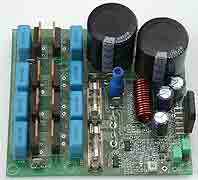Listening experience
Click on the picture to get a larger view.
I, Per-Anders Sjöström says:
With MUR3020 diodes, 2 x 4700 uF heavy duty caps ELNA LPJ3, 200 VA, 2 x 24 VAC, buffer AD8620, otherwise according to the original design, this amp really sings.
Reptile fast deep bass, snappy, firm, dry, warmth in the mids, razor-sharp treble, very good "S"-sounds, simply a crystal clear sound. I'm quite surprised that the LM3886 is as good as it really is.
I think everyone should be aware of that this LM3886 isn't the solution for every audio problem but it's an excellent start for the Do-It-Yourself hobby. Some loudspeakers will probably don't like the LM3886 but pretty many will.
Walter from Belgium says this:
As stated in my previous posts, my findings regarding the sound of the amp are exactly the same as Andy's. The thing works is magic from the first second. While other amps need a break-in period, this one produces a clear and detailed sound right after you finished assembling. Bass is well proportioned, yet not dominant. The high's are crispy but not that annoying SSSS timbre. The mid's are in my case a bit pronounced but this is speaker related. As soon as my other hobbyroom / bedroom speakers are finished I will have a better picture. The overall sound is very coherent and quite pleasing.
I also noticed that some sounds, like little bells and echoes, are not coming from the speakers. These are things that I didn't heard before, which is weird because some of the CD's that I've tested with I played many times before. I can't say if it runs cooler or hotter than my other amps. This is related on how loud you play and for how long. Absolutely no clicks or plops or whatever when powering up or off. Only things needed are some in-and output connectors and a transformer, and if you really need it a power on/off switch.
My monoblocks are equipped with 225 VA tranny's and 2A fuses. After cranking it up quite hard, just wanted to know how hard it could play, the fuses didn't blew. Regarding the SMD stuff I can see no reason why this should scare anyone of. I had absolutely no problems with soldering those little suckers. If one works carefully and don't rush things this is not more difficult than through hole. To conclude: a very nice and pleasant sounding amp, compact design and very complete. To P-A my compliments on a job "well done".
One week later....
In general my comments of previous posts still stands. What I do experience now after listening for a certain period of time that some of the harshness, if I even can call it that, is gone. Is it because the components are settling in or am I getting used to the sound I don't know. The music it reproduces is very smooth, detailed and open. What I like the most is the spatial image the amplifier creates. I'm also still amazed by the fact that a $5 chip accompanied by some SMD's can produce such a mature sound. All I can say is that this little amplifier produces a BIG sound.
Anders from Norway says this:
My observations so far:
- Very silent switch on and off.
- The sound was very good right from the start (no burn-in needed).
- It's very quiet regarding to hiss and 50 Hz even if my temporarily wiring are very spaghetti-like.
- It's slightly warmer (temperature) than my LM3875.
- I like the sound - very open and detailed without getting harsh.
- It's nice to have everything on one board (only add transformer).
- Fairly easy to build if you have two soldering irons and a good magnifying glass - even with my shaking hands.
This is a successful project!
One week later....
Same with me (as with Walter). I have been playing a lot of CD's and are often amazed with the clarity and perspective of the sound.
The result have been better than my expectations.
My goal is to build active 3-ways speakers with 4 amps pr. speaker (two for the bass)
Why is it so good?
At the moment only three QRP-02 are built but all three produces as good quality as the LM3886 can. Some people claim that this isn't high-end and wrinkle their noses. OK, but it is very close and high-class "mid-end" is very good in this case. My idea why this is so good is the usage of an extremely good input buffer, together with an inverting mode LM3886 and also usage of low resistors values in the feedback. One other thing is the output filter which importance not shall be underestimated. Since the zobel network is made of SMD parts the high frequency characteristics are very good and works very good and does a very good job as frequency compensation for the output stage of the LM3886.

